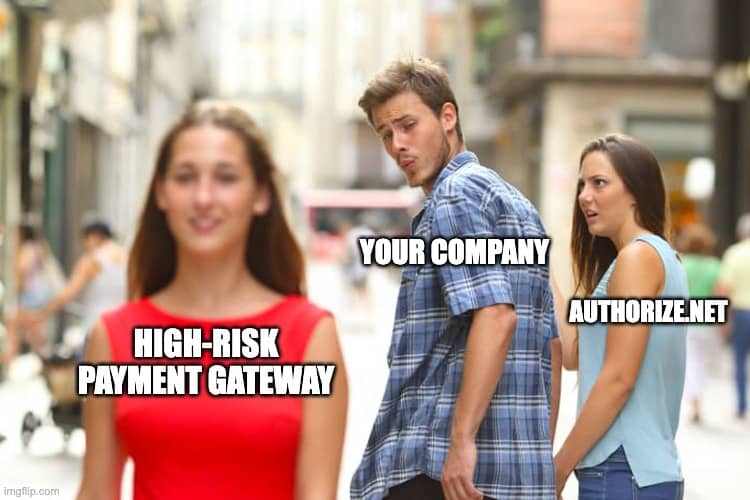Load Balancing Merchant Accounts: 2023 Strategy

Owning a business can be one of the most rewarding endeavors ever. At the same time, it comes with great responsibility. For instance, there aren’t many businesses today that don’t have some online presence. If you want to sell your merchandise or service to online shoppers, they can’t pull out their wallets and hand you cash. You need to have a merchant account.
The responsibilities of maintaining a merchant account in today’s cybersecurity climate can collapse even the strongest of businesses catastrophically. Identity theft, fraud, chargebacks, and other challenges are somewhat out of your control. Still, if your business’s merchant account gets suspended, you face an uphill battle in finding another merchant services provider that’ll work with your business.
Our credit card payment processing solution specialists understand the frustration of a suspended or closed merchant account. We’re the high-risk merchant account experts.
Because a closed or suspended account can practically close your business’s doors for good, some merchants try everything at their disposal to ensure it doesn’t happen. One of the strategies these stressed business owners sometimes turn to is load balancing.
Table of Contents
- What is load balancing?](#h-what-is-load-balancing)
- Why do merchants consider load balancing their merchant accounts?
- Are there any benefits to load balancing your merchant accounts?
- Is load balancing merchant accounts illegal?
- What are some alternatives to load balancing merchant accounts?
- Chargeback prevention and management tools
- Discovering all the data hiding in your reports and analyzing it
- Create comprehensive chargeback management and prevention strategy without resorting to load balancing
- Partner with Zenti
What is load balancing?
The practice of load balancing merchant accounts is much like it sounds: A merchant balances the store’s load of transactions among several merchant accounts. Other names used to refer to load balancing include:
- Transaction distributing
- Transaction routing
- Volume routing
- Volume distributing
- Cascade distribution
While it has multiple names, the overall process is the same:
- Load balancing separates a business’s credit card transactions and routes certain payments through a different merchant account (and sometimes many different merchant accounts).
- Load balancing a merchant account routes these transactions through several payment processing companies to avoid a merchant account closure.
For instance, imagine a retail store that sells high-end luxury purses and shoes. Maybe the store owner had perfect credit and secured a traditional merchant account when the store first opened, even though theirs is considered a high-risk industry. However, over time, multiple sales for big-ticket items and finicky shoppers unhappy with a pair of pumps caused one chargeback too many, and the store received a warning from the merchant account provider that its merchant account was at risk of closure.
Some businesses might have started using a load balancing strategy well before the account provider sent a warning. Regardless, the store owner seeks and opens another merchant account or two. Maybe even a high-risk merchant account in the event the original, traditional account gets closed. Once these new merchant accounts are set up, the store sets up its payment gateway to evenly distribute purchase transactions between the original and the new merchant accounts. The idea is that the fewer transactions getting processed through any one account, the lower the chances of a transaction breaching the rules of the merchant account or, possibly worse, credit card company thresholds. All credit card companies publish [chargeback reason codes and ratio limits. Visa’s guidelines for merchant chargeback ratios warrant a 93-page document that Visa merchants must abide by.
But breaching chargeback ratios is just one aspect of potential merchant account closure.
Why do merchants consider load balancing their merchant accounts?
All merchants bear some risk of credit card fraud or chargeback disputes. But eCommerce merchants are especially vulnerable. Online stores often have higher chargeback ratios than their brick-and-mortar counterparts, and usually, it’s through no fault of the online merchant. In fact, friendly fraud is one of the greatest threats to an online merchant’s reputation with credit card payment processors.
Even though it sounds harmless, friendly fraud is not at all like its name suggests. A “friendly, yet fraudulent” instance can happen:
- After a customer makes a purchase and then disputes it once the product or service is received because something is wrong with the order (instead of initiating a return).
- Like the above, but it’s an honest mistake: Sometimes shoppers forget what they bought!
- A child uses a parent’s credit card to order merchandise, and the parent disputes the charges, not knowing what they’re for.
While none of the above are outright malicious, it doesn’t matter to the credit card brands. Chargebacks are chargebacks, and they don’t paint your business in a good light. But this type of chargeback is impossible to plan for and even harder to fight. Friendly fraud is what typically sends most online merchants above their allowed chargeback ratio. In an effort to turn the tables, store owners (believing load balancing is their last chance to keep their doors open) decide to save their business through load balancing merchant accounts, and many of these business owners have no idea they’re engaging in a deceptively unethical action. In fact, some have even found out the hard way: Most credit card companies view load balancing as a way for businesses to skirt credit card brand restrictions and, therefore, a violation of terms.
But there’s a better way to protect your business than dodging the rules. A high-risk merchant account is a great place to start.
Before we entirely dismiss the practice of load balancing, because we have to show some solidarity with business owners who honestly had no idea this practice was deceptive, we should ask: Does it actually work? What makes this practice so attractive to business owners?
Are there any benefits to load balancing your merchant accounts?
Diehard fans of load balancing offer multiple reasons why they swear by the practice.
For instance, consider the following:
- If your business generates over $100,000 each month and you’re running all those transactions through one business merchant account, any disruptions to your payment acceptance methods could spell financial disaster.
- All transactions, from all branded credit cards, debit cards, and maybe even EBT card payments if your business is a large grocery chain, run through the same terminal and the same merchant account.
- An online merchant might be accepting payments from around the country or around the world. Even packages getting shipped to the East Coast from California can take several days. Customers on the other side of the world might give up waiting and initiate a chargeback.
All of the above can result in dings to a merchant account, and all at once can mean bye-bye to a merchant account. See ya later storefront.
So, business owners who practice load balancing look at these odds and figure it’s worth it. After all, many businesses have more than one merchant account anyway, usually as a backup in the event one account is closed or suspended.
Balancing your transactions between multiple accounts can mean fewer chargebacks per merchant account, which automatically gives your business the appearance of higher conversions and fewer losses.
And what if a small percentage of your credit card declines (small, yes, but large enough to matter) weren’t because of anything you or your customers did at all? A staggering number of annual credit card declines happen because transactions aren’t routed properly. In fact, Aite Research Group predicted in 2019 that losses due to false declines would top 444 billion USD by 2021 and soon surpass annual losses attributed to fraud.
Load balancing lets you choose the rules that apply to your payment gateway, setting transactions to route to the closest, most acceptable acquiring bank. This action alone dramatically improves approval success rates.
Finally, load balancing puts control of your transaction volume in your hands. Rather than paying additional fees and surcharges because you went over your plan’s allowed number of transactions, you can keep all merchant accounts in satisfactory condition.
Those are impressive reasons and help forge an understanding of why so many business owners resort to transaction balancing. The risks, however, far outweigh these seeming benefits. Load balancing isn’t an advisable method of running your business long-term.
But, you might ask, is balancing transactions against the law? Surely, if it’s against the law, fewer business owners would even attempt this practice.
Is load balancing merchant accounts illegal?
Before we answer that question, consider this:
At the end of any business day, you close out your registers and run end-of-shift and end-of-day reports from each cash register.
Then you count the cash, ensure the till balances, and begin matching credit and debit card receipts to your shift reports.
Can you imagine how confusing it’d be to perform this end-of-day ritual with the added task of matching those credit card payment entries and receipts to the correct payment processor?
Sure, you can opt for payment gateways that tie all your merchant accounts into one giant report in one spot. But how feasible is that?
So, is load balancing illegal? Surprisingly, no.
But credit card brands don’t endorse the practice and can refuse you services if you’re caught. Having several merchant accounts might help a high-volume store stay on top of chargebacks and transactions, but overall: don’t try this at home.
So, then, what’s the good news? How can you keep your merchant account in good standing without resorting to unethical behavior?
What are some alternatives to load balancing merchant accounts?
Well, you might be happy to hear that there are other, better methods to keep your accounts in good standing that don’t involve the risks of load balancing. Consider these merchant account load balancing alternatives:
Chargeback prevention and management tools
To really rein in your chargebacks, get a handle on them, and manage them going forward, you need to understand why your customers disputed those transactions in the first place. Don’t assume. Instead, use the data you already have at your disposal to create (trackable!) metrics and start tracking. The more intelligent decisions you’re about to make, decisions are driven by data, are right around the corner.
Some of the items you can turn into trackable metrics you can analyze for meaning include:
- Reason codes
- Country of transaction’s origin
- Average overall ticket price of chargebacks
- The average price point of products or services disputed
- The time between sale and chargeback, also known as lag time
While you can track and analyze these metrics yourself, a chargeback prevention and management program can help tremendously. But if you’re just putting together your chargeback prevention posse, it can take some time to generate the data you need to make some informed decisions. So, a few chargeback and fraud management ideas you can implement right now are the next best thing:
- Use an order validation method to share information with banks and empower dispute mitigation.
- Sign up for a chargeback prevention alert system that lets you send customers a refund before a dispute becomes a chargeback.
- 3rd-party programs can help you identify potential chargeback transactions before they happen so you can block the purchase.
- Implement additional measures, such as address verification, CVV capture, and 3D Secure technology for identity verification.
Taking a multi-pronged approach like this drastically reduces your exposure to fraud and chargebacks and helps keep your business protected.
Discovering all the data hiding in your reports and analyzing it
You’d be hard-pressed to find a business owner today who doesn’t swear by data measurements. Once you pick a metric and track it, oh, the information, it delivers! With an understanding of why your chargebacks happened, you can prevent their occurrence in the future.
Analyzing past and present transactions lets you make better decisions because you know the answers to such questions as:
- Are our digital products disputed more often than physical items?
- Do recurring payments get disputed more often than single payments?
- Do your customers in other countries dispute purchases more often than customers in your own country?
- Do chargebacks seem to increase beyond a certain ticket price?
- Could some of your marketing strategies be to blame for some transaction disputes?
- Are your transaction disputes honest mistakes or done maliciously?
These answers alone offer you insight into more than just how you can dodge a chargeback fee. These answers light the way to better business practices, helping you improve every aspect of your store, from product quality to customer service.
Create comprehensive chargeback management and prevention strategy without resorting to load balancing
Chargeback management and prevention isn’t just safer; it actually turns ROI positive (increasingly so when you combine multiple fraud-fighting solutions). Who needs the unsafe and potential account closure scares of load balancing your merchant accounts?
Good tools collect all the information you need to shield your business from chargebacks and boost your wins when the occasional dispute slips through the cracks.
Partner with Zenti
Our credit card payment processing specialists can put together exactly the right merchant account according to your business’s needs. Contact our payments specialists today to learn more.
Read Next

Find out whether Authorize.Net works for high risk merchants, what restrictions you might face and how to get approved.

Get expert advice on selling CBD products on Shopify, including compliance tips and setting up secure payment options.

Find out why Square may deactivate merchant accounts and steps to resolve issues and maintain uninterrupted payment services.
Need a High-Risk Merchant Account?
Disruption-free payment processing at the best price for your situation, guaranteed.
Get Free Guidance Now!